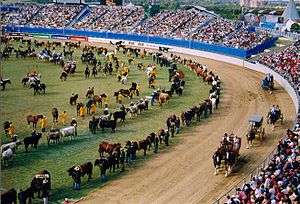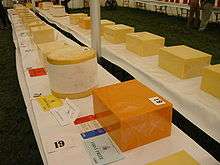Agricultural show
An agricultural show is a public event exhibiting the equipment, animals, sports and recreation associated with agriculture and animal husbandry. The largest comprise a livestock show (a judged event or display in which breeding stock is exhibited), a trade fair, competitions, and entertainment. The work and practices of farmers, animal fanciers, cowboys, and zoologists may be displayed. The terms agricultural show and livestock show are synonymous with the North American terms county fair and state fair.

Agricultural shows are an important part of cultural life in small country towns, and a popular event in larger towns and cities. Shows range from small events in small country towns usually lasting two days, through medium-sized events of three days, to large shows, which may run for up to two weeks and combine elements of an amusement park with those of an agricultural show. Although in many countries agriculture shows are increasingly under financial pressure, many towns or areas have a show society and in some areas, several towns and villages in the area all have an annual show. Larger shows often include live entertainment and fireworks in the main arena.
The first known agricultural show was held by Salford Agricultural Society, Lancashire, in 1768.[1]
Events

Since the 19th century, agricultural shows have provided local people with an opportunity to celebrate achievements and enjoy a break from day-to-day routine.[2] With a combination of serious competition and light entertainment, annual shows acknowledged and rewarded the hard work and skill of primary producers and provided a venue for rural families to socialise. City shows also provide city people with an opportunity to engage directly with rural life and food production.[3]
Agriculture shows are often enlivened with competitive events, including sheaf tossing, show jumping, food competitions, and tent pegging. Demolition derbies and rodeos are popular in the US and campdrafting and wood chopping are often held in Australia.
Studs are generally available for a fee.
Livestock shows

A livestock show is an event where livestock are exhibited and judged on certain phenotypical breed traits as specified by their respective breed standard. Species of livestock that may be shown include pigs, cattle, sheep, goats, horses, rabbits, llamas, and alpacas.[4] Poultry such as chickens, geese, ducks, turkeys, and pigeons are also shown competitively.[5] There are also competitive shows for dogs, sheepdogs, and cats.
Prize-winners at agricultural shows are generally awarded inscribed medals, cups, rosettes or ribbons. The National Museum of Australia has a rare collection of medals documenting the history of agricultural shows and rural industries across Australia.[3] The 111 medals range in date from the mid-19th to the early 20th century and many are associated with significant individuals and organizations.[6]
Agricultural shows and swine influenza
Background
Agricultural shows can be sources of swine influenza transmission in both animal and human populations. Swine influenza is a communicable disease caused by one of several different strains of influenza A virus. Currently, the subtypes of influenza A virus which have been identified in pig populations within the United States are referred to as H1N1, H1N2, and H3N2, all named for their specific genetic makeups.[7] These viruses are extremely common in pigs across various industries, including pig showmanship at agricultural fairs, and are easily passed between pigs when proper hygiene and safety measures are not carried out.
It is rare for the virus to spread to humans; however, genetic reassortment can lead to susceptibility among humans.[8] Due to direct contact with infected animals or a contaminated environment, swine influenza strains can be transmitted to human populations.[9] In cases such as the 2009 flu pandemic, the virus was transmitted from swine to humans and caused a global pandemic which led to the deaths of approximately 12,000 people in the United States alone.[10] For this reason, people who work or spend any time in close proximity with pigs are at risk for infection and must follow specific precautions to prevent the spread of swine influenza.
Swine influenza risk
Certain populations at agricultural fairs are at increased risk of developing serious complications after swine influenza exposure. For instance, pregnant women are more susceptible to swine influenza and have been shown to have increased rates of swine influenza mortality relative to the general population.[11] Similarly, adolescents, infants, and those with serious medical comorbid conditions have disproportionately high rates of mortality with swine influenza.[12] This is concerning as over 3.5 million children in the United States participate in youth agricultural programs every year.[13]
Agricultural fairs can readily lead to swine influenza infection in vulnerable populations because agricultural fairs are frequently visited by entire families, including children and pregnant women. Persons who visit agricultural fairs during a known outbreak of swine influenza should be aware of the potential signs and symptoms of infection. The most common symptoms of swine flu are very nonspecific and include fever, cough, malaise, nausea, and vomiting.[14] Importantly, individuals can have swine flu and exhibit no symptoms whatsoever. In certain populations, however, swine flu can lead to serious medical complications including organ damage and/or death. Individuals with recent swine exposure need to be aware of the symptoms of swine flu and have a low threshold to seek medical care.
Recent swine flu variant outbreaks in the United States
Swine influenza variant viruses have been responsible for several recent outbreaks in the United States associated with contact with pigs at agricultural fairs. The three main Influenza A viruses responsible for these outbreaks are variants of the Influenza A viruses H1N1, H1N2, and H3N2.
Recent swine influenza variant outbreaks associated with agriculture fairs in the United States:
- 2009: global spread of H1N1, starting from the United States in April 2009. On 11 June 2009 the World Health Organization issued an imminent pandemic alert. At this time, 70 countries reported ongoing outbreaks, and over 1 million ongoing cases were documented in the United States alone. H1N1 is now a regularly occurring human influenza virus that continues to circulate seasonally and globally with the other influenza viruses.[15]
- 2012: 306 confirmed cases identified of H3N2 in 10 different states. Over 80% of cases were found in Ohio and Indiana. Human-to-human transmission is thought to have caused 15 cases, but the rest all reported direct or indirect contact with swine, mostly at agricultural fairs.[16] (See image)
_variant_virus_cases.png) Geographic distribution of influenza A (H3N2) cases (July–Sept 2012)
Geographic distribution of influenza A (H3N2) cases (July–Sept 2012) - 2016: 18 confirmed cases in Ohio and Michigan between July and August 2016. All cases reported pig exposure at least one of seven agricultural fairs between the two states.[17]
- 2017: 40 confirmed cases of H3N2 occurred in Maryland after swine exposure at one of three agricultural fairs. 35 of the cases occurred in people in the high-risk category for influenza complications.[18]
Preventing the spread of flu in people and pigs
In the United States, agricultural fairs are a significant exposure source for swine influenza.[19] It is essential to understand that certain strains of swine influenza can be transmitted from pig to pig, pig to human, human to human, and that swine influenza infection does not always show signs of illness.[20]
There are a variety of safety precautions that should be taken at agricultural fairs to prevent the spread of swine influenza. Vulnerable communities including children, people aged 65 years and older, pregnant women, and those suffering from long-term health conditions are groups who should avoid swine exposure due to their high-risk status.[21] The CDC specifically recommends that high-risk individuals with known medical complications avoid interaction with swine at agricultural fairs.[22] It is advised that anyone who develops flu symptoms after swine exposure at agricultural fairs contact their physician for appropriate medical consultation.
There are other recommended prevention strategies to reduce the spread of swine influenza at agricultural fairs. It is suggested that people do not bring food into pig areas, do not take any items such as toys, pacifiers or similar items near the pig areas, avoid close contact with any pigs, and wash hands before and after handling pigs.[23] Given the severity of the disease, it is prudent to adopt safety precautions to limit the spread of the swine flu.
Field days
Related to a show is the "field day", with elements of a trade show for machinery, equipment and skills required for broadacre farming. Field days typically do not involve livestock, showbags or sideshows, but may include events such as ploughing competitions not usually associated with shows due to the larger space required. In some communities in northern England Field Days (or Club Days) have lost their agricultural character and have become community celebrations.
The events are good sources of agricultural information, as organizers can arrange for guest speakers to talk on a range of topics, such as the talk on the yellow-flowering alfalfa at the South Dakota field day.[24] Pecan growers were given a talk on insect control by an entomologist at a recent field day at LSU AgCenter's Pecan Research/Extension Station in Shreveport, La.[25]
A Landcare survey conducted in 1992/93 revealed that field days in Australia have a high value among local farmers.[26] New Zealand's National Agricultural Fieldays is held annually in June at Mystery Creek, near Hamilton, New Zealand, and attracts 1,000 exhibitors and over 115,000 visitors through its gates.[27] Smaller shows, held annually in New Zealand's towns and communities, are generally called agricultural and pastoral shows (A&P shows).
List of agricultural shows
Asia
South America
Oceania
.svg.png)
Incomplete list of shows in Australia:[28]
- Ballarat Show
- Beaudesert Show
- Bendigo Show
- Boonah Show
- Bream Creek Show
- Gold Coast Show
- Gympie District Show
- Huon Show
- Kangaroo Valley Show
- Kalbar Show
- Kingaroy Show
- Korumburra Show
- Mareeba Rodeo and Agricultural Show
- Mildura Show
- Moss Vale Show
- Mudgeeraba Show
- Nanango Show
- Newcastle Regional Show
- Nowra Show
- Robertson Show
- Royal Adelaide Show
- Royal Bathurst Show
- Royal Brisbane Show, the Ekka
- Royal Canberra Show
- Royal Darwin Show
- Royal Geelong Show
- Royal Hobart Show
- Royal Launceston Show
- Royal Melbourne Show
- Royal Norfolk Island Show
- Royal Perth Show
- Royal Toowoomba Show
- Royal Queensland Show
- Sydney Royal Easter Show
- Wanneroo Agricultural Show
- Warragul Show
- Warrnambool Show
North America
.svg.png)
- Ayer's Cliff Fair - Ayer's Cliff, Quebec
- Brome Fair - Brome, Quebec
- Calgary Stampede - Calgary, Alberta
- Canadian National Exhibition - Toronto, Ontario
- Canadian Western Agribition - Regina, Saskatchewan
- Farm Fair - Prince Albert, Saskatchewan
- Grande Prairie Stompede - Grande Prairie, Alberta
- Hants County Exhibition - Windsor, Nova Scotia
- Royal Agricultural Winter Fair - Toronto, Ontario
- Royal Manitoba Winter Fair - Brandon, Manitoba
- Schomberg Fair - Schomberg, Ontario

- Denbigh Agricultural Show : The Denbigh Show is the oldest, largest and most dynamic agricultural show in the English-speaking Caribbean, and one of Jamaica's most iconic events, and was held for the first time in 1952. The Denbigh Show has achieved the name for the Caribbean's premier agricultural event, and epitomizes wholesome family entertainment and attracts over 80,000 patrons to the event annually.[29]

- American Royal – Kansas City, Missouri
- Brooklyn Fair – Brooklyn, Connecticut
- Clay County Fair – Spencer, Iowa
- Dutchess County Fair - America's County Fair - Rhinebeck, New York
- El Dorado County Fair – Placerville, California
- Elkhart County 4-H Fair - Goshen, Indiana
- Erie County Fair - Hamburg, New York
- Farm Progress Show – Dacatur and Boone, Iowa (alternate years)
- Fort Worth Stock Show and Rodeo – Fort Worth, Texas
- Fulton County Fair - Wauseon, Ohio
- Great Allentown Fair - Allentown, Pennsylvania
- Houston Livestock Show and Rodeo – Houston, Texas
- National Farm Machinery Show – Louisville, Kentucky
- National Western Stock Show – Denver, Colorado
- North American International Livestock Exposition – Louisville, Kentucky
- Pennsylvania Farm Show – Harrisburg, Pennsylvania
- San Antonio Stock Show & Rodeo – San Antonio, Texas
- Topsfield Fair – Topsfield, Massachusetts
Africa

- Bathurst Agricultural Show - Bathurst
- Rand Easter Show - Johannesburg
- The Royal Agricultural Show www.royalshow.co.za - Pietermaritzburg
- Nampo - Bothaville
Nairobi international trade fair [Nairobi]
Europe

- Bakewell Show - Bakewell, Derbyshire
- Balmoral Show - Northern Ireland
- Cheshire County Show
- Devon County Show
- East of England Show – Peterborough, Cambridgeshire
- Emley Show - Emley, West Yorkshire
- Grassland & Muck
- Great Yorkshire Show – Harrogate, North Yorkshire[30]
- Monmouth Show – Monmouth, Monmouthshire
- North Devon Show
- Newport Show – Newport, Shropshire
- The New Forest and Hampshire County Show
- Royal County of Berkshire Show - Thatcham, Berkshire
- Royal Show – Stoneleigh, Warwickshire (now defunct)
- Royal Highland Show – Ingliston, Edinburgh
- Royal Isle of Wight Agricultural Society - Cowes, Isle of Wight
- Royal Norfolk Show – Costessey, Norfolk
- Royal Welsh Show – Llanelwedd, Powys
- Royal Bath and West Show – Shepton Mallet, Somerset
- Royal Cornwall Agricultural Show – Wadebridge, Cornwall
- Royal Three Counties - Malvern, Worcestershire
- Shropshire and West Midlands Show
- Stanhope Show
- Suffolk Show
- Tendring Hundred Show
- Wensleydale Agricultural Show
- Westmorland County Show
See also
References
- Patrick Robertson (2011). Robertson's Book of Firsts: Who Did What for the First Time. Bloomsbury Publishing. ISBN 9781608197385.
- "Collection - Agricultural shows on ASO - Australia's audio and visual heritage online". aso.gov.au.
- "David Allen agricultural medals - National Museum of Australia". www.nma.gov.au.
- Ekarius, Carol (2008). Storey's Illustrated Breed Guide to Sheep, Goats, Cattle and Pigs. Storey Publishing. ISBN 978-1-60342-036-5.
- Ekarius, Carol (2007). Storey's Illustrated Guide to Poultry Breeds. Storey Publishing. ISBN 978-1-58017-667-5.
- David Allen collection agricultural medals purchased by the National Museum - images and details
- Swine influenza. The Merck Veterinary Manual. 2008. ISBN 978-1-4421-6742-1. Archived from the original on 4 March 2016. Retrieved 25 October 2019.
- Jilani, T. N., Jamil, R. T., & Siddiqui, A. H. (9 June 2019). H1N1 Influenza (Swine Flu). Retrieved 25 October 2019, from https://www.ncbi.nlm.nih.gov/books/NBK513241/.
- Key Facts about Human Infections with Variant Viruses. (3 January 2019). Retrieved from https://www.cdc.gov/flu/swineflu/keyfacts-
- CDC Estimates of 2009 H1N1 Influenza Cases, Hospitalizations and Deaths in the United States, April 2009 – 13 February 2010. (n.d.). Retrieved from https://www.cdc.gov/H1N1flu/estimates/April_February_13.htm#targetText=Updated Estimates from April – 14 November 2009&targetText=CDC estimated that between 34,people infected with 2009 H1N1.
- Maternal and Infant Outcomes Among Severely Ill Pregnant and Postpartum Women with 2009 Pandemic Influenza A (H1N1) – United States, April 2009–August 2010. (2011). Morbidity and Mortality Weekly Report, 60(35), 1193-1196.
- Louie, J., Acosta, Winter, Jean, Gavali, Schechter, . . . California Pandemic Working Group. (2009). Factors Associated With Death or Hospitalization Due to Pandemic 2009 Influenza A(H1N1) Infection in California. JAMA: The Journal of the American Medical Association, 302(17), 1896-1902.
- Stewart, R.J., Rossow, J., Conover, J.T., et al. (2018). Do animal exhibitors support and follow recommendations to prevent transmission of variant influenza at agricultural fairs? A survey of animal exhibitor households after a variant influenza virus outbreak in Michigan. Zoonoses Public Health, 65(1), 195– 201. doi:10.1111/zph.12425
- Crum-Cianflone, N., Blair, P., Faix, D., Arnold, J., Echols, S., Sherman, S., . . . Hale, B. (2009). Clinical and Epidemiologic Characteristics of an Outbreak of Novel H1N1 (Swine Origin) Influenza A Virus among United States Military Beneficiaries. Clinical Infectious Diseases, 49(12), 1801-1810.
- Centers for Disease Control and Prevention (CDC). (2010). The 2009 H1N1 Pandemic: Summary Highlights, April 2009-April 2010. Retrieved on 25 October 2019 from https://www.cdc.gov/h1n1flu/cdcresponse.htm
- Jhung, M. A., Epperson, S., Biggerstaff, M., Allen, D., Balish, A., Barnes, N., … Finelli, L. (2013). Outbreak of variant influenza A (H3N2) virus in the United States. Clinical infectious diseases: an official publication of the Infectious Diseases Society of America, 57(12), 1703–1712. doi:10.1093/cid/cit649
- Bowman, A. S., Walia, R. R., Nolting, J. M., Vincent, A. L., Killian, M., Zentkovich, M. M....Forshey, T. (2017). Influenza A(H3N2) Virus in Swine at Agricultural Fairs and Transmission to Humans, Michigan and Ohio, USA, 2016. Emerging Infectious Diseases, 23(9), 1551-1555. doi:10.3201/eid2309.170847.
- Duwell, M.M., Blythe, D., Radebaugh, M.W., et al. (2018). Influenza A(H3N2) Variant Virus Outbreak at Three Fairs – Maryland, 2017. MMWR Morb Mortal Wkly Rep, 67(42),1169–1173. doi:10.15585/mmwr.mm6742a1
- Bowman, A. S., Walia, R. R., Nolting, J. M., Vincent, A. L., Killian, M., Zentkovich, M....Forshey, T. (2017). Influenza A(H3N2) Virus in Swine at Agricultural Fairs and Transmission to Humans, Michigan and Ohio, USA, 2016. Emerging Infectious Diseases, 23(9),1551-1555. doi:10.3201/eid2309.170847
- National Association of State Public Health Veterinarians: Zoonotic Influenza, 2018.Retrieved from: http://nasphv.org/documentsCompendiaZoonoticInfluenza.html
- CDC People at High Risk for Flu Complications, August 27th 2018. Retrieved from: https://www.cdc.gov/flu/highrisk/index.htm?CDC_AA_refVal=https%3A%2F%2Fwww.cdc.gov%2Fflu%2Fabout%2Fdisease%2Fhigh_risk.htm
- First Variant Virus Infection of 2018 Linked to Pig Exposure at an Agricultural Fair in Indiana | CDC. (2019). Cdc.gov. Retrieved 26 October 2019, from https://www.cdc.gov/flu/news/variant-virus-2018.htm
- CDC Take Actions to Prevent the Spread of the Flu Between Pigs and People, July 24th 2019. Retrieved from: https://www.cdc.gov/flu/swineflu/prevention.html
- "Yellow-flowering alfalfa topic of June 26 field day". High Plains Midwest Ag Journal. Archived from the original on 21 June 2008. Retrieved 21 June 2008.
- Van Osdell, Mary Ann. "Pecan field day provides latest information". Delta Farm Press. Archived from the original on 5 August 2008. Retrieved 21 June 2008.
- Conacher, Arthur; Conacher, Jeanette (1995). Rural Land Degradation in Australia. South Melbourne, Victoria: Oxford University Press Australia. p. 138. ISBN 0-19-553436-0.
- Fieldays Retrieved on 29 November 2008
- http://agshowsnsw.org.au/index.php/shows
- Society, Jamaica Agricultural. "Denbigh Agricultural Industrial Food Show". jas.gov.jm.
- "Greatest show on turf opens gates". BBC News. 8 July 2008. Retrieved 17 July 2008.
